Evaluating HR Policies for Alignment with Business Strategy
VerifiedAdded on 2022/11/18
|9
|2171
|289
Report
AI Summary
This report critically evaluates the Human Resource (HR) policies of the National Bank of Trinidad and Tobago, assessing their alignment with the bank's business strategy. The report identifies the bank's core HR principles, including its emphasis on employee well-being and development. It analyzes the bank's code of conduct, resource-based approach to HR, and roles and responsibilities as defined in its HR policy. The analysis highlights the impact of HR policies on employee behavior, organizational citizenship, and turnover intentions. The report recommends improvements to the bank's compensation strategy, suggesting a more detailed budget allocation for employee remuneration and benefits. It also proposes a more structured performance management system, including annual objectives, employee development programs, and regular performance appraisals. Furthermore, the report emphasizes the importance of well-structured administration, including detailed information on compensation processes. The conclusion underscores the significance of HR policies as a strategic investment that fosters a positive organizational culture and supports the bank's long-term success. The report is a valuable resource for students studying human resource management, providing practical insights into policy evaluation and improvement.
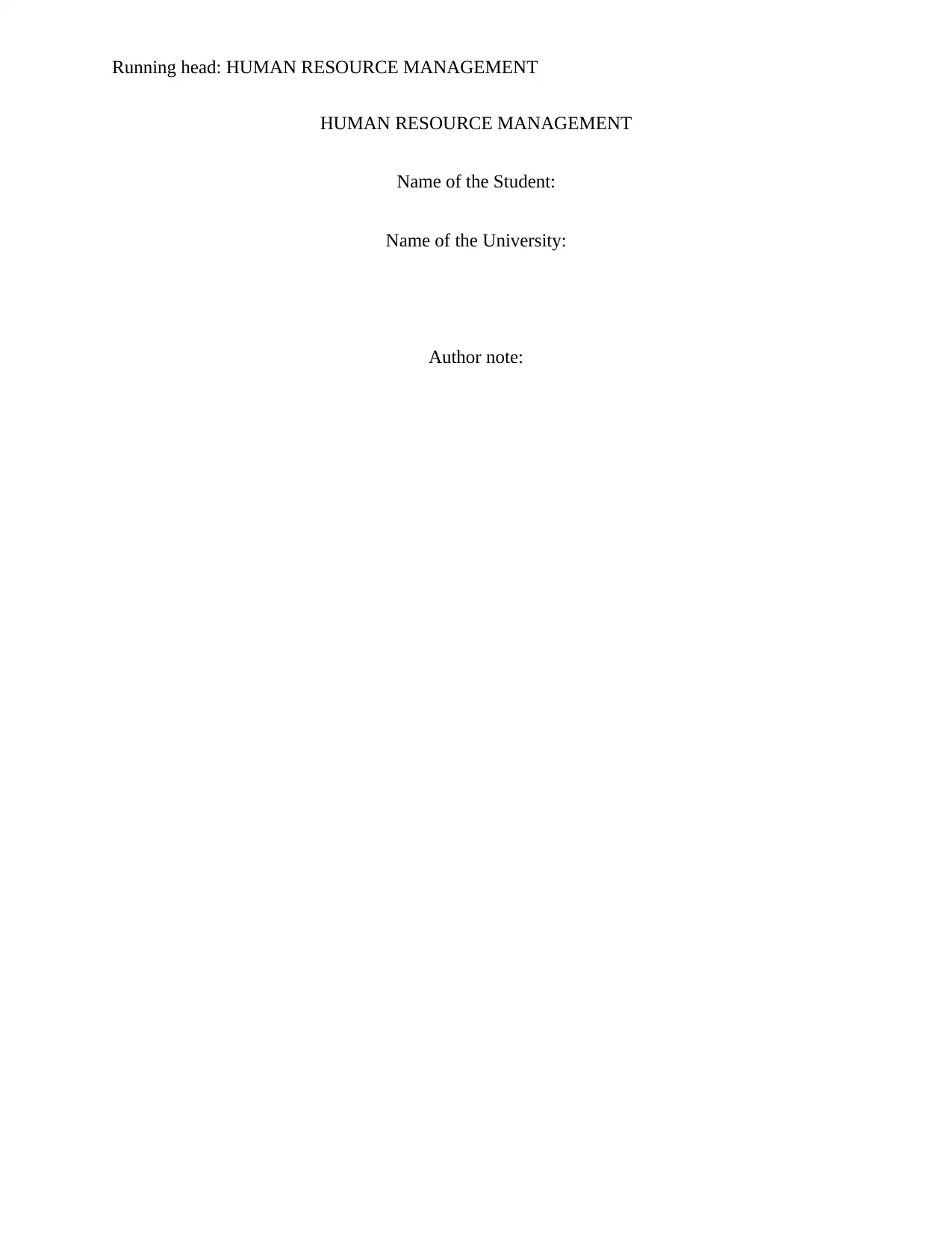
Running head: HUMAN RESOURCE MANAGEMENT
HUMAN RESOURCE MANAGEMENT
Name of the Student:
Name of the University:
Author note:
HUMAN RESOURCE MANAGEMENT
Name of the Student:
Name of the University:
Author note:
Paraphrase This Document
Need a fresh take? Get an instant paraphrase of this document with our AI Paraphraser
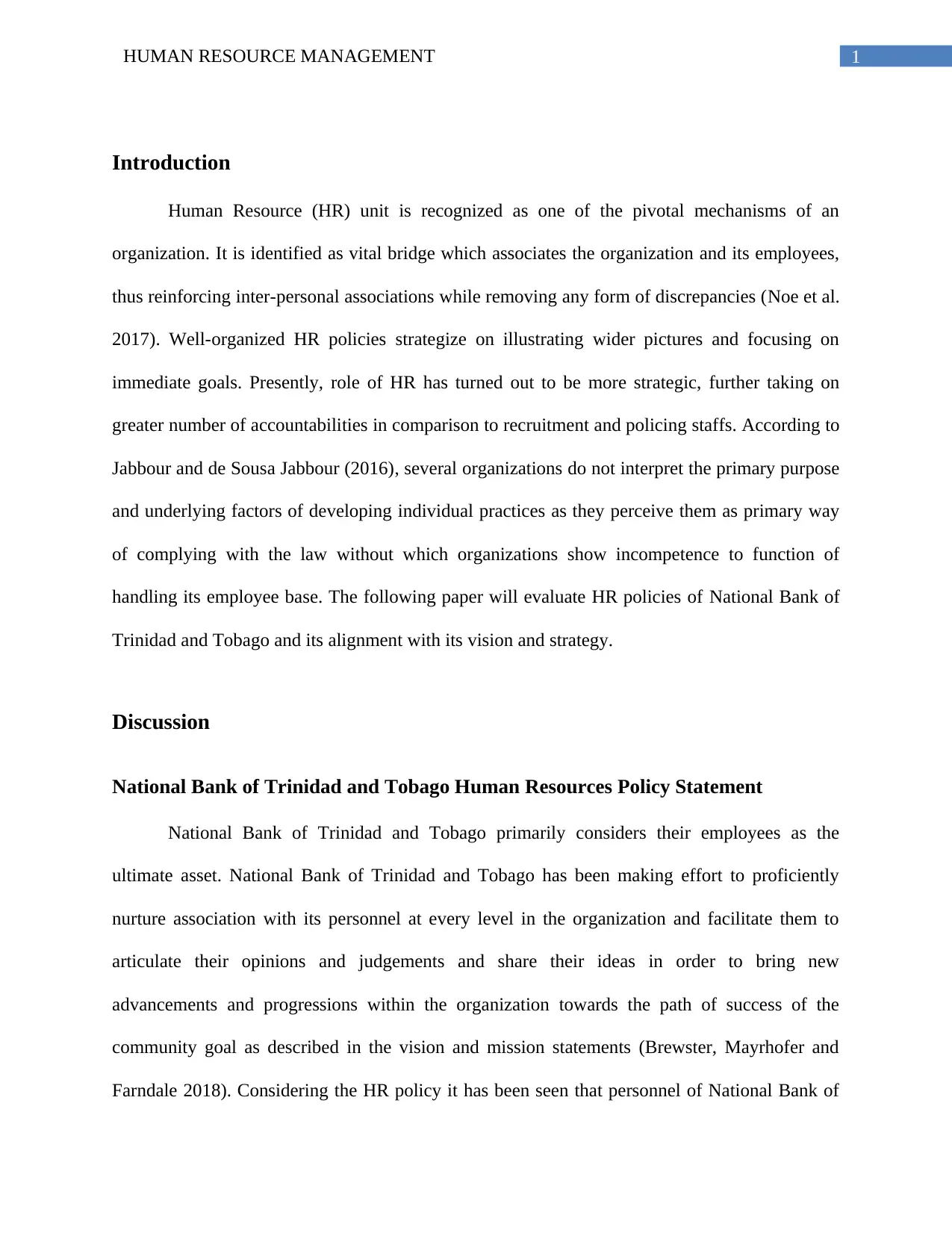
1HUMAN RESOURCE MANAGEMENT
Introduction
Human Resource (HR) unit is recognized as one of the pivotal mechanisms of an
organization. It is identified as vital bridge which associates the organization and its employees,
thus reinforcing inter-personal associations while removing any form of discrepancies (Noe et al.
2017). Well-organized HR policies strategize on illustrating wider pictures and focusing on
immediate goals. Presently, role of HR has turned out to be more strategic, further taking on
greater number of accountabilities in comparison to recruitment and policing staffs. According to
Jabbour and de Sousa Jabbour (2016), several organizations do not interpret the primary purpose
and underlying factors of developing individual practices as they perceive them as primary way
of complying with the law without which organizations show incompetence to function of
handling its employee base. The following paper will evaluate HR policies of National Bank of
Trinidad and Tobago and its alignment with its vision and strategy.
Discussion
National Bank of Trinidad and Tobago Human Resources Policy Statement
National Bank of Trinidad and Tobago primarily considers their employees as the
ultimate asset. National Bank of Trinidad and Tobago has been making effort to proficiently
nurture association with its personnel at every level in the organization and facilitate them to
articulate their opinions and judgements and share their ideas in order to bring new
advancements and progressions within the organization towards the path of success of the
community goal as described in the vision and mission statements (Brewster, Mayrhofer and
Farndale 2018). Considering the HR policy it has been seen that personnel of National Bank of
Introduction
Human Resource (HR) unit is recognized as one of the pivotal mechanisms of an
organization. It is identified as vital bridge which associates the organization and its employees,
thus reinforcing inter-personal associations while removing any form of discrepancies (Noe et al.
2017). Well-organized HR policies strategize on illustrating wider pictures and focusing on
immediate goals. Presently, role of HR has turned out to be more strategic, further taking on
greater number of accountabilities in comparison to recruitment and policing staffs. According to
Jabbour and de Sousa Jabbour (2016), several organizations do not interpret the primary purpose
and underlying factors of developing individual practices as they perceive them as primary way
of complying with the law without which organizations show incompetence to function of
handling its employee base. The following paper will evaluate HR policies of National Bank of
Trinidad and Tobago and its alignment with its vision and strategy.
Discussion
National Bank of Trinidad and Tobago Human Resources Policy Statement
National Bank of Trinidad and Tobago primarily considers their employees as the
ultimate asset. National Bank of Trinidad and Tobago has been making effort to proficiently
nurture association with its personnel at every level in the organization and facilitate them to
articulate their opinions and judgements and share their ideas in order to bring new
advancements and progressions within the organization towards the path of success of the
community goal as described in the vision and mission statements (Brewster, Mayrhofer and
Farndale 2018). Considering the HR policy it has been seen that personnel of National Bank of
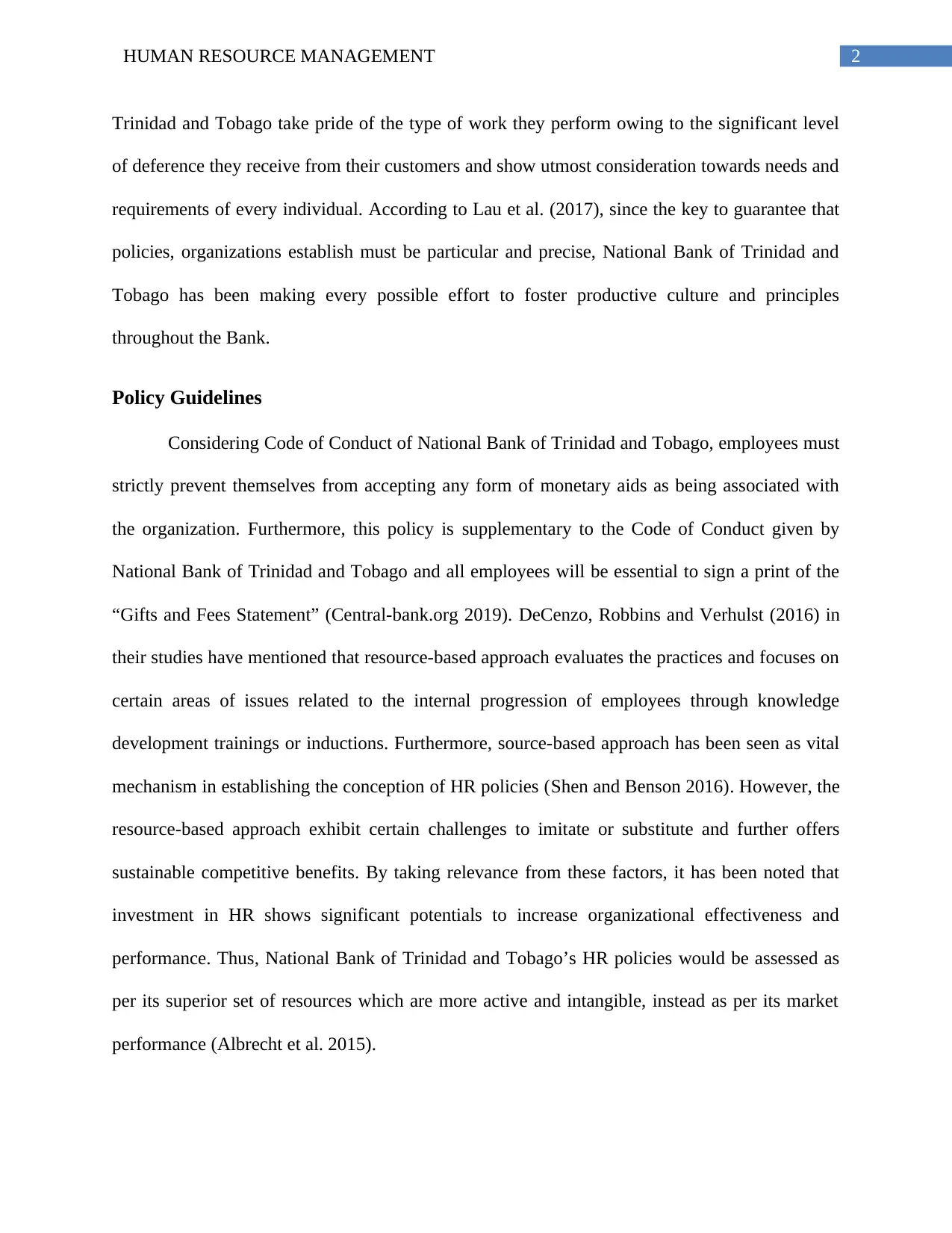
2HUMAN RESOURCE MANAGEMENT
Trinidad and Tobago take pride of the type of work they perform owing to the significant level
of deference they receive from their customers and show utmost consideration towards needs and
requirements of every individual. According to Lau et al. (2017), since the key to guarantee that
policies, organizations establish must be particular and precise, National Bank of Trinidad and
Tobago has been making every possible effort to foster productive culture and principles
throughout the Bank.
Policy Guidelines
Considering Code of Conduct of National Bank of Trinidad and Tobago, employees must
strictly prevent themselves from accepting any form of monetary aids as being associated with
the organization. Furthermore, this policy is supplementary to the Code of Conduct given by
National Bank of Trinidad and Tobago and all employees will be essential to sign a print of the
“Gifts and Fees Statement” (Central-bank.org 2019). DeCenzo, Robbins and Verhulst (2016) in
their studies have mentioned that resource-based approach evaluates the practices and focuses on
certain areas of issues related to the internal progression of employees through knowledge
development trainings or inductions. Furthermore, source-based approach has been seen as vital
mechanism in establishing the conception of HR policies (Shen and Benson 2016). However, the
resource-based approach exhibit certain challenges to imitate or substitute and further offers
sustainable competitive benefits. By taking relevance from these factors, it has been noted that
investment in HR shows significant potentials to increase organizational effectiveness and
performance. Thus, National Bank of Trinidad and Tobago’s HR policies would be assessed as
per its superior set of resources which are more active and intangible, instead as per its market
performance (Albrecht et al. 2015).
Trinidad and Tobago take pride of the type of work they perform owing to the significant level
of deference they receive from their customers and show utmost consideration towards needs and
requirements of every individual. According to Lau et al. (2017), since the key to guarantee that
policies, organizations establish must be particular and precise, National Bank of Trinidad and
Tobago has been making every possible effort to foster productive culture and principles
throughout the Bank.
Policy Guidelines
Considering Code of Conduct of National Bank of Trinidad and Tobago, employees must
strictly prevent themselves from accepting any form of monetary aids as being associated with
the organization. Furthermore, this policy is supplementary to the Code of Conduct given by
National Bank of Trinidad and Tobago and all employees will be essential to sign a print of the
“Gifts and Fees Statement” (Central-bank.org 2019). DeCenzo, Robbins and Verhulst (2016) in
their studies have mentioned that resource-based approach evaluates the practices and focuses on
certain areas of issues related to the internal progression of employees through knowledge
development trainings or inductions. Furthermore, source-based approach has been seen as vital
mechanism in establishing the conception of HR policies (Shen and Benson 2016). However, the
resource-based approach exhibit certain challenges to imitate or substitute and further offers
sustainable competitive benefits. By taking relevance from these factors, it has been noted that
investment in HR shows significant potentials to increase organizational effectiveness and
performance. Thus, National Bank of Trinidad and Tobago’s HR policies would be assessed as
per its superior set of resources which are more active and intangible, instead as per its market
performance (Albrecht et al. 2015).
⊘ This is a preview!⊘
Do you want full access?
Subscribe today to unlock all pages.

Trusted by 1+ million students worldwide
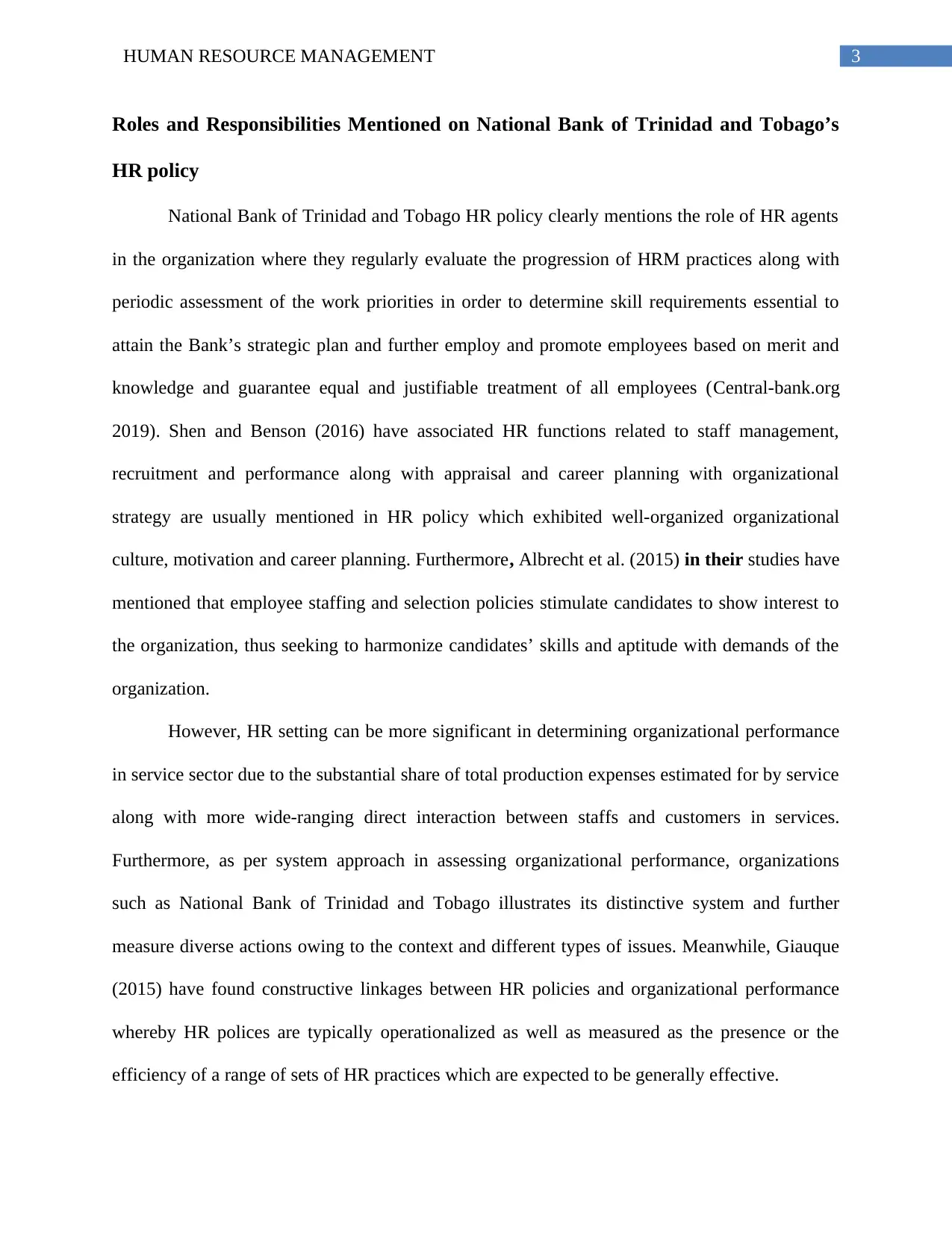
3HUMAN RESOURCE MANAGEMENT
Roles and Responsibilities Mentioned on National Bank of Trinidad and Tobago’s
HR policy
National Bank of Trinidad and Tobago HR policy clearly mentions the role of HR agents
in the organization where they regularly evaluate the progression of HRM practices along with
periodic assessment of the work priorities in order to determine skill requirements essential to
attain the Bank’s strategic plan and further employ and promote employees based on merit and
knowledge and guarantee equal and justifiable treatment of all employees (Central-bank.org
2019). Shen and Benson (2016) have associated HR functions related to staff management,
recruitment and performance along with appraisal and career planning with organizational
strategy are usually mentioned in HR policy which exhibited well-organized organizational
culture, motivation and career planning. Furthermore, Albrecht et al. (2015) in their studies have
mentioned that employee staffing and selection policies stimulate candidates to show interest to
the organization, thus seeking to harmonize candidates’ skills and aptitude with demands of the
organization.
However, HR setting can be more significant in determining organizational performance
in service sector due to the substantial share of total production expenses estimated for by service
along with more wide-ranging direct interaction between staffs and customers in services.
Furthermore, as per system approach in assessing organizational performance, organizations
such as National Bank of Trinidad and Tobago illustrates its distinctive system and further
measure diverse actions owing to the context and different types of issues. Meanwhile, Giauque
(2015) have found constructive linkages between HR policies and organizational performance
whereby HR polices are typically operationalized as well as measured as the presence or the
efficiency of a range of sets of HR practices which are expected to be generally effective.
Roles and Responsibilities Mentioned on National Bank of Trinidad and Tobago’s
HR policy
National Bank of Trinidad and Tobago HR policy clearly mentions the role of HR agents
in the organization where they regularly evaluate the progression of HRM practices along with
periodic assessment of the work priorities in order to determine skill requirements essential to
attain the Bank’s strategic plan and further employ and promote employees based on merit and
knowledge and guarantee equal and justifiable treatment of all employees (Central-bank.org
2019). Shen and Benson (2016) have associated HR functions related to staff management,
recruitment and performance along with appraisal and career planning with organizational
strategy are usually mentioned in HR policy which exhibited well-organized organizational
culture, motivation and career planning. Furthermore, Albrecht et al. (2015) in their studies have
mentioned that employee staffing and selection policies stimulate candidates to show interest to
the organization, thus seeking to harmonize candidates’ skills and aptitude with demands of the
organization.
However, HR setting can be more significant in determining organizational performance
in service sector due to the substantial share of total production expenses estimated for by service
along with more wide-ranging direct interaction between staffs and customers in services.
Furthermore, as per system approach in assessing organizational performance, organizations
such as National Bank of Trinidad and Tobago illustrates its distinctive system and further
measure diverse actions owing to the context and different types of issues. Meanwhile, Giauque
(2015) have found constructive linkages between HR policies and organizational performance
whereby HR polices are typically operationalized as well as measured as the presence or the
efficiency of a range of sets of HR practices which are expected to be generally effective.
Paraphrase This Document
Need a fresh take? Get an instant paraphrase of this document with our AI Paraphraser
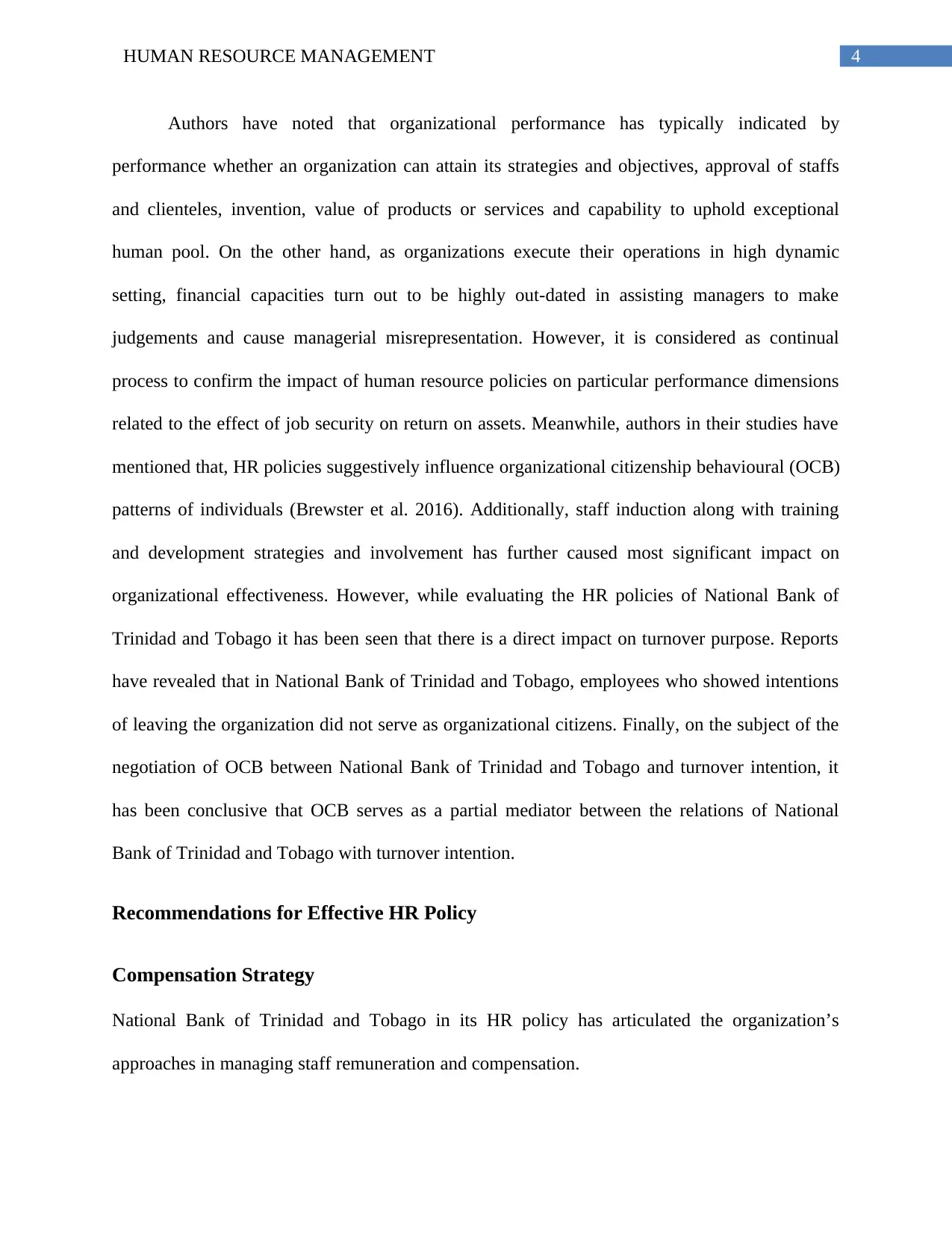
4HUMAN RESOURCE MANAGEMENT
Authors have noted that organizational performance has typically indicated by
performance whether an organization can attain its strategies and objectives, approval of staffs
and clienteles, invention, value of products or services and capability to uphold exceptional
human pool. On the other hand, as organizations execute their operations in high dynamic
setting, financial capacities turn out to be highly out-dated in assisting managers to make
judgements and cause managerial misrepresentation. However, it is considered as continual
process to confirm the impact of human resource policies on particular performance dimensions
related to the effect of job security on return on assets. Meanwhile, authors in their studies have
mentioned that, HR policies suggestively influence organizational citizenship behavioural (OCB)
patterns of individuals (Brewster et al. 2016). Additionally, staff induction along with training
and development strategies and involvement has further caused most significant impact on
organizational effectiveness. However, while evaluating the HR policies of National Bank of
Trinidad and Tobago it has been seen that there is a direct impact on turnover purpose. Reports
have revealed that in National Bank of Trinidad and Tobago, employees who showed intentions
of leaving the organization did not serve as organizational citizens. Finally, on the subject of the
negotiation of OCB between National Bank of Trinidad and Tobago and turnover intention, it
has been conclusive that OCB serves as a partial mediator between the relations of National
Bank of Trinidad and Tobago with turnover intention.
Recommendations for Effective HR Policy
Compensation Strategy
National Bank of Trinidad and Tobago in its HR policy has articulated the organization’s
approaches in managing staff remuneration and compensation.
Authors have noted that organizational performance has typically indicated by
performance whether an organization can attain its strategies and objectives, approval of staffs
and clienteles, invention, value of products or services and capability to uphold exceptional
human pool. On the other hand, as organizations execute their operations in high dynamic
setting, financial capacities turn out to be highly out-dated in assisting managers to make
judgements and cause managerial misrepresentation. However, it is considered as continual
process to confirm the impact of human resource policies on particular performance dimensions
related to the effect of job security on return on assets. Meanwhile, authors in their studies have
mentioned that, HR policies suggestively influence organizational citizenship behavioural (OCB)
patterns of individuals (Brewster et al. 2016). Additionally, staff induction along with training
and development strategies and involvement has further caused most significant impact on
organizational effectiveness. However, while evaluating the HR policies of National Bank of
Trinidad and Tobago it has been seen that there is a direct impact on turnover purpose. Reports
have revealed that in National Bank of Trinidad and Tobago, employees who showed intentions
of leaving the organization did not serve as organizational citizens. Finally, on the subject of the
negotiation of OCB between National Bank of Trinidad and Tobago and turnover intention, it
has been conclusive that OCB serves as a partial mediator between the relations of National
Bank of Trinidad and Tobago with turnover intention.
Recommendations for Effective HR Policy
Compensation Strategy
National Bank of Trinidad and Tobago in its HR policy has articulated the organization’s
approaches in managing staff remuneration and compensation.
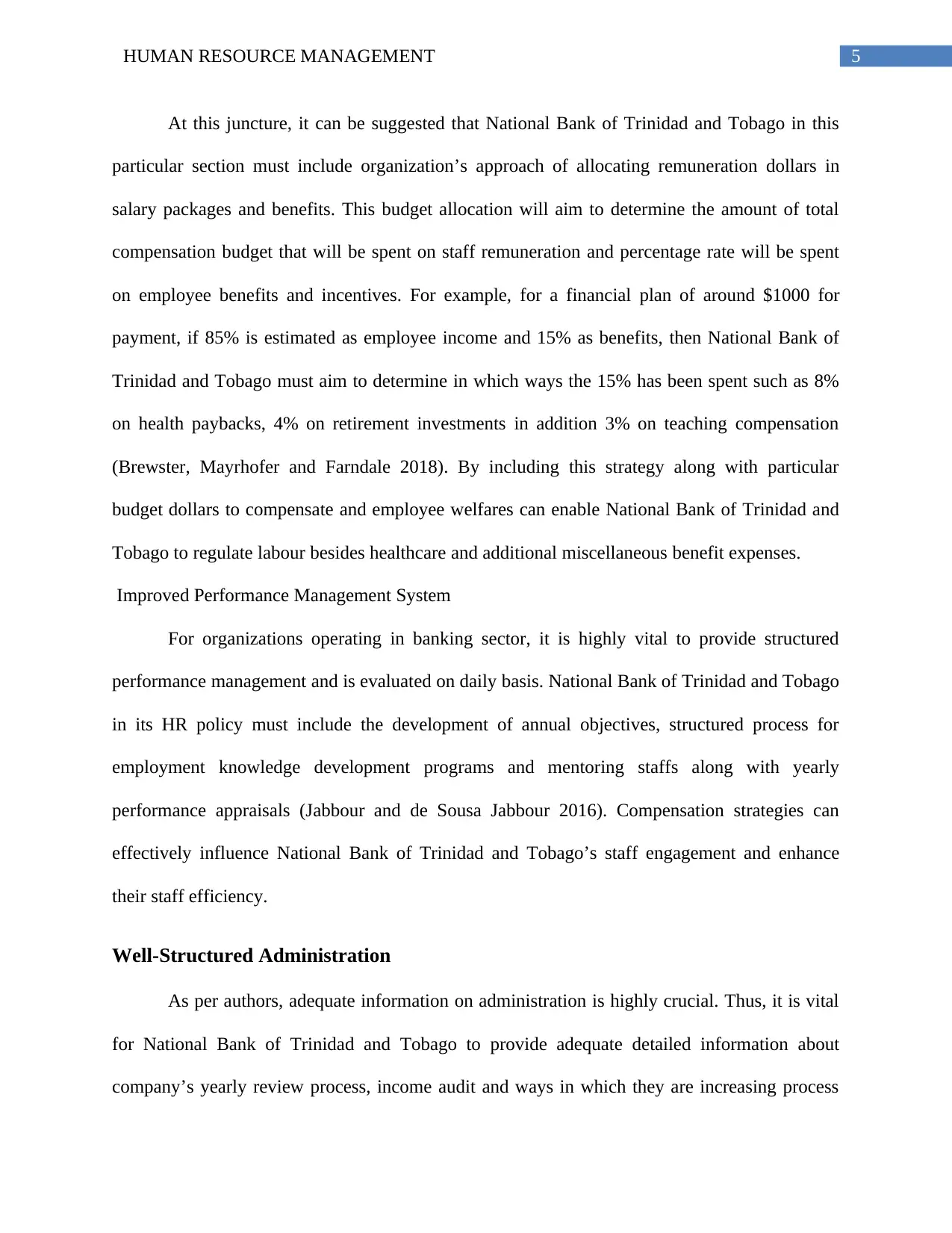
5HUMAN RESOURCE MANAGEMENT
At this juncture, it can be suggested that National Bank of Trinidad and Tobago in this
particular section must include organization’s approach of allocating remuneration dollars in
salary packages and benefits. This budget allocation will aim to determine the amount of total
compensation budget that will be spent on staff remuneration and percentage rate will be spent
on employee benefits and incentives. For example, for a financial plan of around $1000 for
payment, if 85% is estimated as employee income and 15% as benefits, then National Bank of
Trinidad and Tobago must aim to determine in which ways the 15% has been spent such as 8%
on health paybacks, 4% on retirement investments in addition 3% on teaching compensation
(Brewster, Mayrhofer and Farndale 2018). By including this strategy along with particular
budget dollars to compensate and employee welfares can enable National Bank of Trinidad and
Tobago to regulate labour besides healthcare and additional miscellaneous benefit expenses.
Improved Performance Management System
For organizations operating in banking sector, it is highly vital to provide structured
performance management and is evaluated on daily basis. National Bank of Trinidad and Tobago
in its HR policy must include the development of annual objectives, structured process for
employment knowledge development programs and mentoring staffs along with yearly
performance appraisals (Jabbour and de Sousa Jabbour 2016). Compensation strategies can
effectively influence National Bank of Trinidad and Tobago’s staff engagement and enhance
their staff efficiency.
Well-Structured Administration
As per authors, adequate information on administration is highly crucial. Thus, it is vital
for National Bank of Trinidad and Tobago to provide adequate detailed information about
company’s yearly review process, income audit and ways in which they are increasing process
At this juncture, it can be suggested that National Bank of Trinidad and Tobago in this
particular section must include organization’s approach of allocating remuneration dollars in
salary packages and benefits. This budget allocation will aim to determine the amount of total
compensation budget that will be spent on staff remuneration and percentage rate will be spent
on employee benefits and incentives. For example, for a financial plan of around $1000 for
payment, if 85% is estimated as employee income and 15% as benefits, then National Bank of
Trinidad and Tobago must aim to determine in which ways the 15% has been spent such as 8%
on health paybacks, 4% on retirement investments in addition 3% on teaching compensation
(Brewster, Mayrhofer and Farndale 2018). By including this strategy along with particular
budget dollars to compensate and employee welfares can enable National Bank of Trinidad and
Tobago to regulate labour besides healthcare and additional miscellaneous benefit expenses.
Improved Performance Management System
For organizations operating in banking sector, it is highly vital to provide structured
performance management and is evaluated on daily basis. National Bank of Trinidad and Tobago
in its HR policy must include the development of annual objectives, structured process for
employment knowledge development programs and mentoring staffs along with yearly
performance appraisals (Jabbour and de Sousa Jabbour 2016). Compensation strategies can
effectively influence National Bank of Trinidad and Tobago’s staff engagement and enhance
their staff efficiency.
Well-Structured Administration
As per authors, adequate information on administration is highly crucial. Thus, it is vital
for National Bank of Trinidad and Tobago to provide adequate detailed information about
company’s yearly review process, income audit and ways in which they are increasing process
⊘ This is a preview!⊘
Do you want full access?
Subscribe today to unlock all pages.

Trusted by 1+ million students worldwide
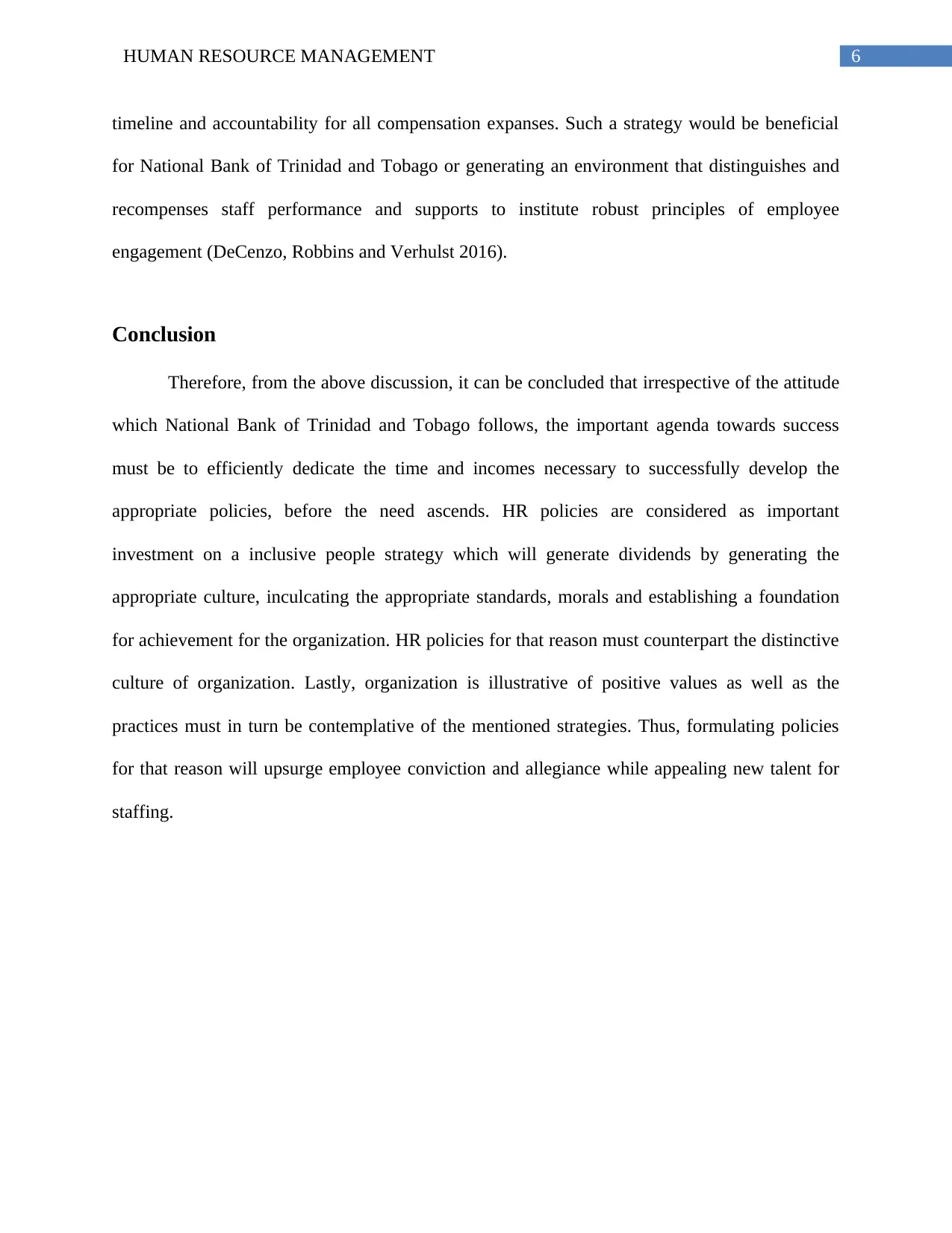
6HUMAN RESOURCE MANAGEMENT
timeline and accountability for all compensation expanses. Such a strategy would be beneficial
for National Bank of Trinidad and Tobago or generating an environment that distinguishes and
recompenses staff performance and supports to institute robust principles of employee
engagement (DeCenzo, Robbins and Verhulst 2016).
Conclusion
Therefore, from the above discussion, it can be concluded that irrespective of the attitude
which National Bank of Trinidad and Tobago follows, the important agenda towards success
must be to efficiently dedicate the time and incomes necessary to successfully develop the
appropriate policies, before the need ascends. HR policies are considered as important
investment on a inclusive people strategy which will generate dividends by generating the
appropriate culture, inculcating the appropriate standards, morals and establishing a foundation
for achievement for the organization. HR policies for that reason must counterpart the distinctive
culture of organization. Lastly, organization is illustrative of positive values as well as the
practices must in turn be contemplative of the mentioned strategies. Thus, formulating policies
for that reason will upsurge employee conviction and allegiance while appealing new talent for
staffing.
timeline and accountability for all compensation expanses. Such a strategy would be beneficial
for National Bank of Trinidad and Tobago or generating an environment that distinguishes and
recompenses staff performance and supports to institute robust principles of employee
engagement (DeCenzo, Robbins and Verhulst 2016).
Conclusion
Therefore, from the above discussion, it can be concluded that irrespective of the attitude
which National Bank of Trinidad and Tobago follows, the important agenda towards success
must be to efficiently dedicate the time and incomes necessary to successfully develop the
appropriate policies, before the need ascends. HR policies are considered as important
investment on a inclusive people strategy which will generate dividends by generating the
appropriate culture, inculcating the appropriate standards, morals and establishing a foundation
for achievement for the organization. HR policies for that reason must counterpart the distinctive
culture of organization. Lastly, organization is illustrative of positive values as well as the
practices must in turn be contemplative of the mentioned strategies. Thus, formulating policies
for that reason will upsurge employee conviction and allegiance while appealing new talent for
staffing.
Paraphrase This Document
Need a fresh take? Get an instant paraphrase of this document with our AI Paraphraser
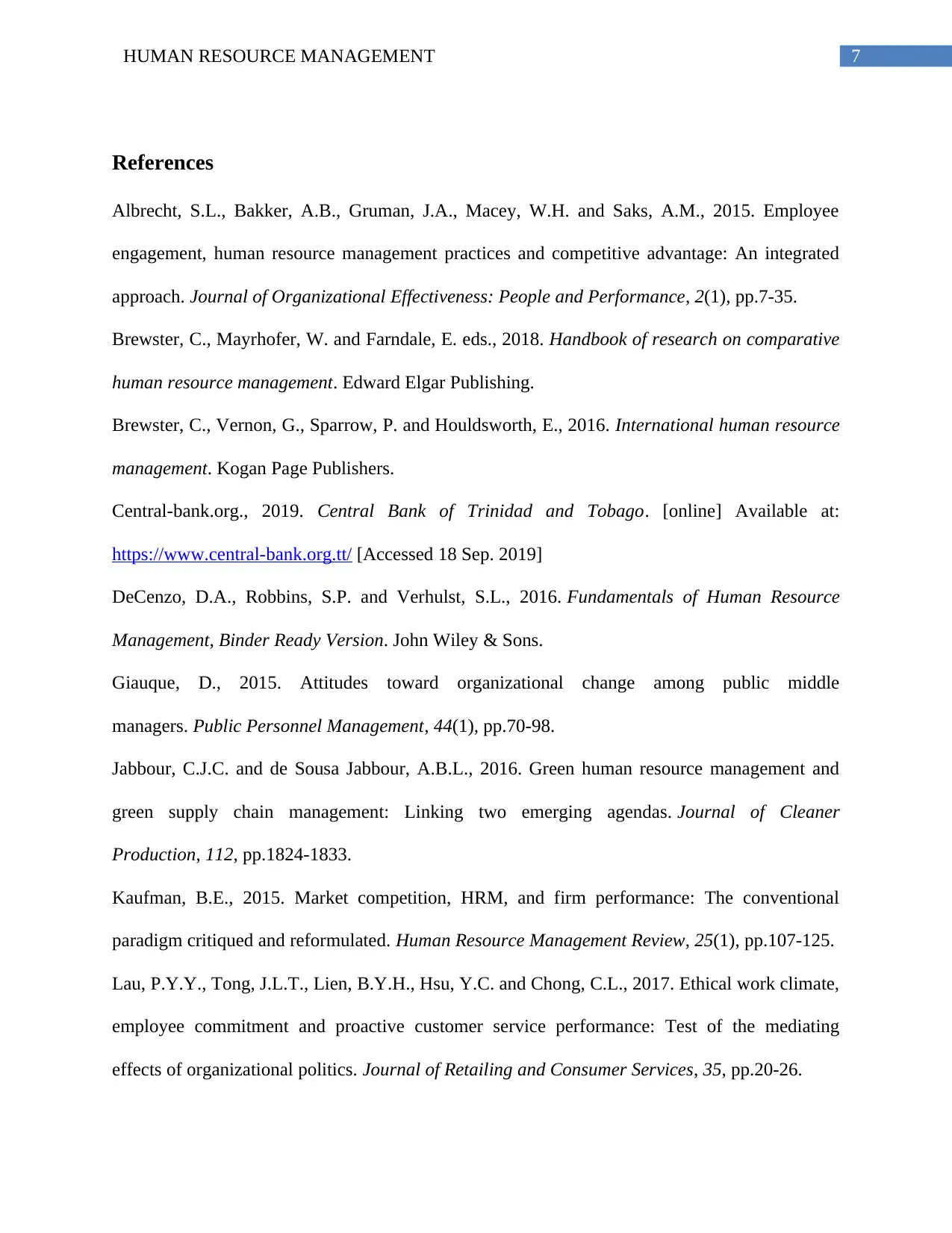
7HUMAN RESOURCE MANAGEMENT
References
Albrecht, S.L., Bakker, A.B., Gruman, J.A., Macey, W.H. and Saks, A.M., 2015. Employee
engagement, human resource management practices and competitive advantage: An integrated
approach. Journal of Organizational Effectiveness: People and Performance, 2(1), pp.7-35.
Brewster, C., Mayrhofer, W. and Farndale, E. eds., 2018. Handbook of research on comparative
human resource management. Edward Elgar Publishing.
Brewster, C., Vernon, G., Sparrow, P. and Houldsworth, E., 2016. International human resource
management. Kogan Page Publishers.
Central-bank.org., 2019. Central Bank of Trinidad and Tobago. [online] Available at:
https://www.central-bank.org.tt/ [Accessed 18 Sep. 2019]
DeCenzo, D.A., Robbins, S.P. and Verhulst, S.L., 2016. Fundamentals of Human Resource
Management, Binder Ready Version. John Wiley & Sons.
Giauque, D., 2015. Attitudes toward organizational change among public middle
managers. Public Personnel Management, 44(1), pp.70-98.
Jabbour, C.J.C. and de Sousa Jabbour, A.B.L., 2016. Green human resource management and
green supply chain management: Linking two emerging agendas. Journal of Cleaner
Production, 112, pp.1824-1833.
Kaufman, B.E., 2015. Market competition, HRM, and firm performance: The conventional
paradigm critiqued and reformulated. Human Resource Management Review, 25(1), pp.107-125.
Lau, P.Y.Y., Tong, J.L.T., Lien, B.Y.H., Hsu, Y.C. and Chong, C.L., 2017. Ethical work climate,
employee commitment and proactive customer service performance: Test of the mediating
effects of organizational politics. Journal of Retailing and Consumer Services, 35, pp.20-26.
References
Albrecht, S.L., Bakker, A.B., Gruman, J.A., Macey, W.H. and Saks, A.M., 2015. Employee
engagement, human resource management practices and competitive advantage: An integrated
approach. Journal of Organizational Effectiveness: People and Performance, 2(1), pp.7-35.
Brewster, C., Mayrhofer, W. and Farndale, E. eds., 2018. Handbook of research on comparative
human resource management. Edward Elgar Publishing.
Brewster, C., Vernon, G., Sparrow, P. and Houldsworth, E., 2016. International human resource
management. Kogan Page Publishers.
Central-bank.org., 2019. Central Bank of Trinidad and Tobago. [online] Available at:
https://www.central-bank.org.tt/ [Accessed 18 Sep. 2019]
DeCenzo, D.A., Robbins, S.P. and Verhulst, S.L., 2016. Fundamentals of Human Resource
Management, Binder Ready Version. John Wiley & Sons.
Giauque, D., 2015. Attitudes toward organizational change among public middle
managers. Public Personnel Management, 44(1), pp.70-98.
Jabbour, C.J.C. and de Sousa Jabbour, A.B.L., 2016. Green human resource management and
green supply chain management: Linking two emerging agendas. Journal of Cleaner
Production, 112, pp.1824-1833.
Kaufman, B.E., 2015. Market competition, HRM, and firm performance: The conventional
paradigm critiqued and reformulated. Human Resource Management Review, 25(1), pp.107-125.
Lau, P.Y.Y., Tong, J.L.T., Lien, B.Y.H., Hsu, Y.C. and Chong, C.L., 2017. Ethical work climate,
employee commitment and proactive customer service performance: Test of the mediating
effects of organizational politics. Journal of Retailing and Consumer Services, 35, pp.20-26.
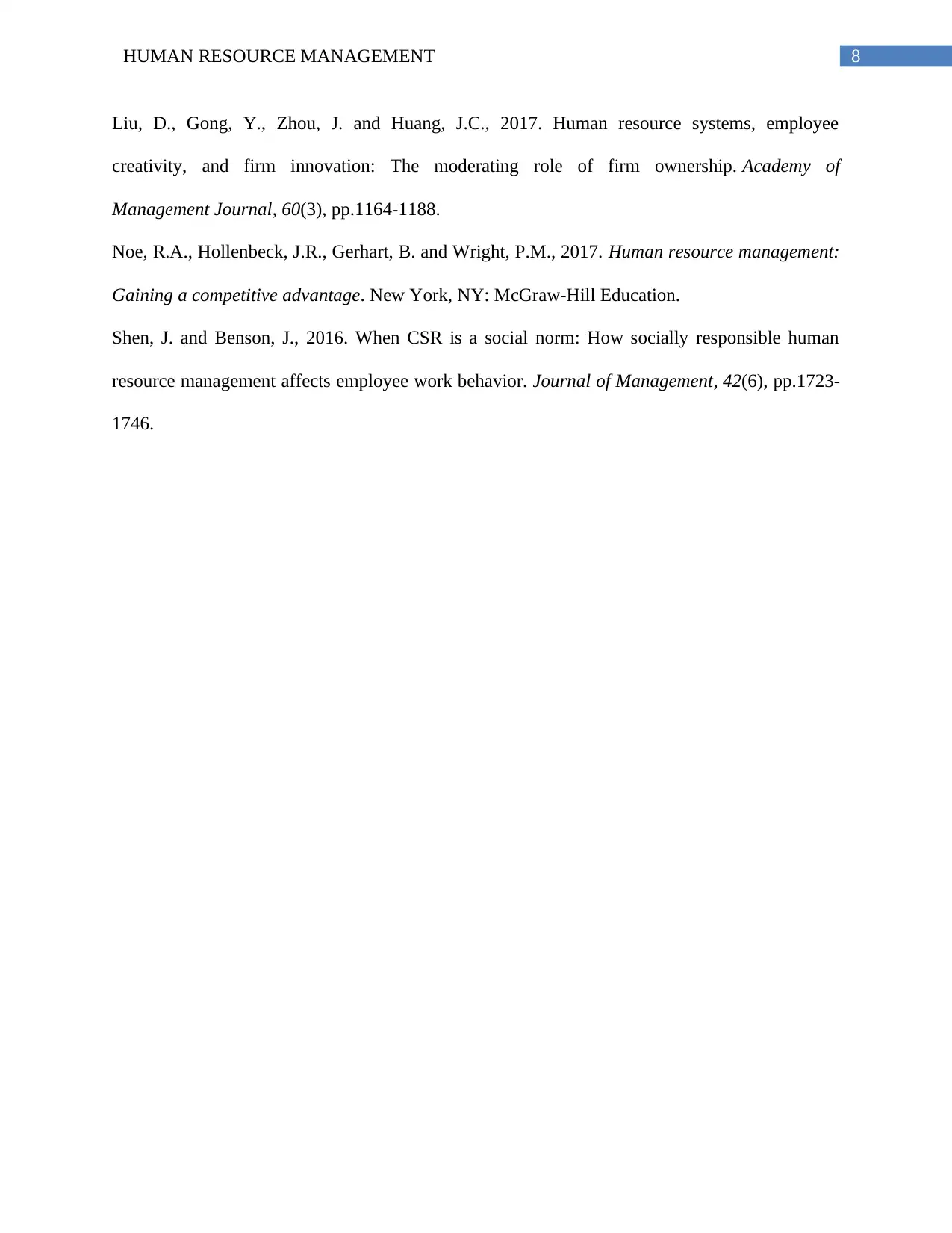
8HUMAN RESOURCE MANAGEMENT
Liu, D., Gong, Y., Zhou, J. and Huang, J.C., 2017. Human resource systems, employee
creativity, and firm innovation: The moderating role of firm ownership. Academy of
Management Journal, 60(3), pp.1164-1188.
Noe, R.A., Hollenbeck, J.R., Gerhart, B. and Wright, P.M., 2017. Human resource management:
Gaining a competitive advantage. New York, NY: McGraw-Hill Education.
Shen, J. and Benson, J., 2016. When CSR is a social norm: How socially responsible human
resource management affects employee work behavior. Journal of Management, 42(6), pp.1723-
1746.
Liu, D., Gong, Y., Zhou, J. and Huang, J.C., 2017. Human resource systems, employee
creativity, and firm innovation: The moderating role of firm ownership. Academy of
Management Journal, 60(3), pp.1164-1188.
Noe, R.A., Hollenbeck, J.R., Gerhart, B. and Wright, P.M., 2017. Human resource management:
Gaining a competitive advantage. New York, NY: McGraw-Hill Education.
Shen, J. and Benson, J., 2016. When CSR is a social norm: How socially responsible human
resource management affects employee work behavior. Journal of Management, 42(6), pp.1723-
1746.
⊘ This is a preview!⊘
Do you want full access?
Subscribe today to unlock all pages.

Trusted by 1+ million students worldwide
1 out of 9
Related Documents
Your All-in-One AI-Powered Toolkit for Academic Success.
+13062052269
info@desklib.com
Available 24*7 on WhatsApp / Email
![[object Object]](/_next/static/media/star-bottom.7253800d.svg)
Unlock your academic potential
Copyright © 2020–2025 A2Z Services. All Rights Reserved. Developed and managed by ZUCOL.





